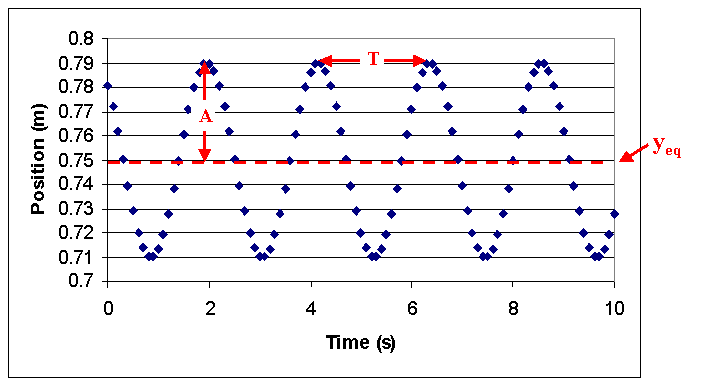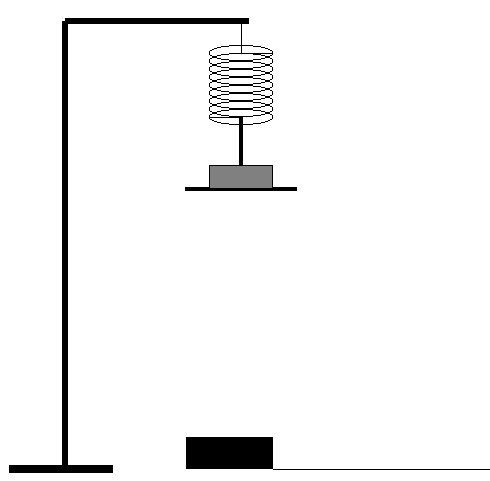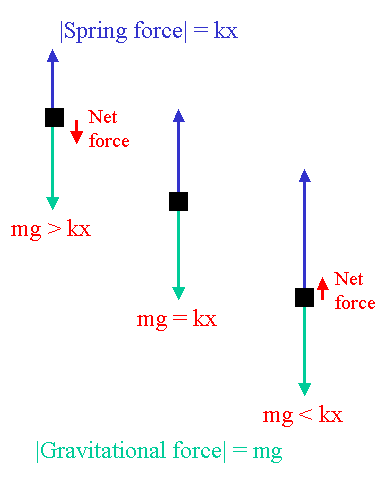  
|
Physics 106 Laboratory: Mass on a Spring
|
  
|

Oscillatory Motion
When a mass is hung vertically from a spring, the spring
stretches. The force on the mass due to the spring is proportional
to the amount the spring is stretched. There is a point at which
the spring force and the weight are equal in magnitude but opposite
in direction. This point is called the equilibrium position.
If the mass is in any other position, there is a net force called the
restoring force directed toward the equilibrium position.
The restoring force results in the mass eventually returning to
the equilibrium position. The mass, however, picks up some
momentum and continues past the equilibrium position causing
the same situation as before but on the opposite side of the
equilibrium position. The outcome is a repeated motion in
which the mass passes through the equilibrium position, turns
around, heads back toward the equilibrium position, passes
through it, and so on. Such behavior is called oscillatory
motion.
(See Chapter 15 in Fundamentals of Physics by Halliday, Resnick and Walker.)
The position of a mass oscillating on a spring can be described
by the following equation
y(t) = yeq + A cos
( 2 π
t / T + φ ).
The term yeq is needed in an experiment because the origin is determined by the location of
the measuring device, thus the origin cannot be chosen to be the equilibrium position as is typically
done in the theoretical account. It is assumed that the argument (the stuff in the parentheses, a.k.a.
"the phase") is in radians and NOT in degrees. Note that there are
four parameters.
-
yeq: the equilibrium position, determines the midpoint of the motion
-
A: the amplitude, determines the size the the oscillations, i.e. the maximum
displacement from the equilibrium position
-
T: the period, determines how much time goes by before the motion begins to repeat itself
-
φ: the phase constant,
determines the part of the cycle at the beginning, when t=0.

Experiment
-
Plug a motion sensor into the PASCO signal interface, the yellow plug should go into Digital Channel 1, the
other into Digital Channel 2.
-
In Data Studio, double click on the Digital Channel 1 icon and choose Motion sensor. Set the trigger
rate to (around) 40 Hz. For our sensors to work properly, the mass and the sensor should be not be too
close.
-
Place a mass on a spring hanging from a tall ringstand with a motion sensor
positioned beneath as shown above. The bar from which the mass hangs should be as far as possible
from the motion sensor (i.e. at the top of the ringstand). Do not change its position during the
experiment or you will have to retake all of your data.
- Mass Variations
-
Record the mass, don't forget to include the mass of the hanger. (Enter the sum in the first column
of the Mass Variations table in the analysis section.) Do not include the mass of the spring, we will
deal with that later.
-
Set the mass into oscillatory motion (stretch the spring approximately three centimeters and release) and
begin recording data. You only need to record a few cycles. Try to ensure that the motion is vertical.
-
Within Data Studio, make a table of the position data. (If you do not have a column
for Time, then click on the clock button to get the times as well.)
-
Copy the columns and paste them into an Excel spreadsheet.
-
Repeat this procedure with several different masses (at least three others, changing the mass by at
least 50 g each time).
-
Use a balance to determine the mass of your spring.
-
Amplitude variations
-
Stretch the spring 1 cm from its equilibrium position and release. Use a watch, phone or whatever
(anything that measures seconds) to record the time required for ten complete oscillations.
Divide that number by ten to obtain the period (the time for one complete oscillation) and enter
it into the table below.
-
Repeat with amplitudes of 2 cm, 3 cm, 4 cm and 5 cm.
Amplitude Variations
| Amplitude (cm) |
Period ( ) |
| 1 |
|
| 2 |
|
| 3 |
|
| 4 |
|
| 5 |
|
Analysis
-
For each of the masses, plot position versus time [an
XY (Scatter) Chart in Excel]. On the same graph, plot a mathematical function that resembles
as much as possible ("fits") your data. Click
here for some instructions for this process.
-
You should be able to identify in your function the equilibrium position, the amplitude,
period and phase constant associated with this oscillatory motion. Include in your report a table
of the masses and this information.
Mass Variations
Mass
without spring
contribution
( ) |
Eq. Pos.
( ) |
Amplitude
( ) |
Period
( ) |
Ph. const.
( ) |
Squares
( ) |
| |
|
|
|
|
|
| |
|
|
|
|
|
| |
|
|
|
|
|
| |
|
|
|
|
|
-
Plot weight versus yeq. Recall that to obtain weight in Newtons,
one multiplies the mass in kilograms by g (9.8 m/s2). Fit this data (i.e. add a
trendline) to a straight line. Extract from the fit the force constant of the spring k.
- The formula
T2 = 4 π2
m / k
comes from squaring both sides of
T = 2 π
√m/k
which is an idealized equation that assumes the spring is massless.
Make a graph of the period squared versus mass
(T2 versus m) Fit your data to a straight line.
-
The absolute value of x intercept of this graph represents the contribution of
the spring's mass to the period. (Note that the constant b in y= m x + b is the
y intercept, not the x intercept.) According to your results, what fraction of the
spring's mass contributes? How does this compare to the theoretical prediction of 1/3?
| Mass of spring ( ) |
x intercept ( ) |
Fraction |
Predicted
Fraction |
Percent
Error |
| |
|
|
1/3 |
|
-
Compare your experimental periods to the theoretical values
T = 2 π
( m / k )1/2.
and to a corrected theory that takes into account the effect of the spring's mass
Tcor = 2 π
[ (m + 0.333 mspring) / k ]1/2.
Exper.
Period
( )
|
Theor.
Period
( )
|
Percent
Difference
( )
|
Corrected
Theor.
Period
( )
|
Percent
Difference
( )
|
| |
|
|
|
|
| |
|
|
|
|
| |
|
|
|
|
| |
|
|
|
|
-
Plot period versus mass (using the data in which the mass was
varied) and period versus amplitude (using the data in which the
amplitude was varied but mass held fixed). Make sure that the two plots
have the same scale on the y axis. (If you need to change the scale on one or
both, right click on the numbers along the y axis and choose Format Axis, select
Axis Options, and enter values in the Minimum and Maximum textboxes. The Auto
checkbox/radiobutton should not be checked.) What can you conclude from this
comparison of period's dependences on mass and amplitude?


















